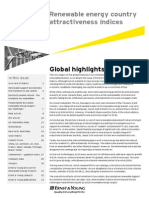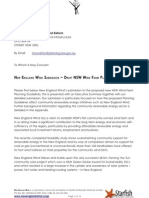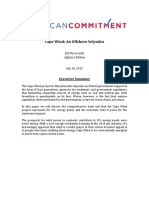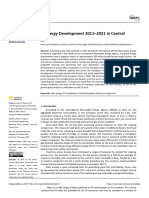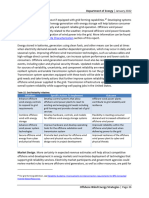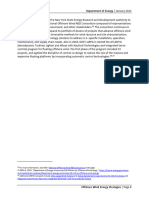Offshore-Wind-Energy-Strategies-Report 12
Offshore-Wind-Energy-Strategies-Report 12
Uploaded by
김대환Copyright:
Available Formats
Offshore-Wind-Energy-Strategies-Report 12
Offshore-Wind-Energy-Strategies-Report 12
Uploaded by
김대환Original Title
Copyright
Available Formats
Share this document
Did you find this document useful?
Is this content inappropriate?
Copyright:
Available Formats
Offshore-Wind-Energy-Strategies-Report 12
Offshore-Wind-Energy-Strategies-Report 12
Uploaded by
김대환Copyright:
Available Formats
Department of Energy | January 2022
III. Offshore Wind Energy Outlook
State of the Global Industry. The global offshore wind energy industry is rapidly expanding.
Offshore wind technology evolved in Northern Europe over the past 20 years and global
installed capacity now exceeds 30 gigawatts (GW). At the end of 2020, the United Kingdom led
the world with the most installed capacity at roughly 10.5 GW. 25 The rest of Europe had
another 13 GW of offshore wind capacity installed across 11 other countries—notably
Germany, Belgium, the Netherlands, and Denmark. 26 Costs have fallen significantly, such that
Germany and the Netherlands have achieved several subsidy-free auctions of offshore wind
energy, 27 although continued reductions are necessary for broad cost competitiveness. Since
2015, China has installed more offshore wind capacity annually than any other country, with
over 7 GW installed by the end of 2020.28 The country also has the largest pipeline of projects in
the planning phase.29 Governments from various countries and the European Union have
invested in developing and demonstrating innovative technologies. Private industry continues
to invest in research and development (R&D), often collaborating with other entities such as
government agencies, research institutions, colleges and universities, and national laboratories.
The U.S. industry has lagged Northern Europe’s, for a number of reasons. Electricity prices tend
to be lower in the United States than in Europe, so it is more difficult for new technologies to
be cost competitive in the U.S. market. Prior to states enacting mandates for offshore wind
energy procurement, the United States lacked the supportive policies that drove the first
decade-plus of European offshore wind energy deployment. In addition, many entities are
involved in the processes required to site and permit power plants in Federal waters and route
cables through state waters, taking significant coordination and time. Needing to navigate
unprecedented and evolving processes means that early projects have missed deadlines and
struggled to secure power purchase agreements.
State of the Domestic Industry and Recent Progress. As of June 2021, the United States has
seven operating offshore wind turbines in two small projects totaling 42 MW of installed
capacity, and 17 active commercial lease areas in Federal waters 30 with 15 commercial projects
that are actively in permitting in those lease areas (see Appendix A4). As discussed in greater
detail later, the Federal Government has recently committed to rapidly increase the scale of
offshore wind development in the United States and progress is being made to do so. Over the
25 Musial, Walt, Beiter, Philipp, Spitsen, Paul, Duffy, Patrick, Marquis, Melinda, Cooperman, Aubryn, Hammond, Robert, Shields,
Matt. 2021. Offshore Wind Market Report: 2021 Edition. Washington, D.C.: U.S. Department of Energy Office of Energy
Efficiency & Renewable Energy. https://energy.gov/eere/wind/articles/offshore-wind-market-report-2021-edition-released.
26 Ibid
27 Jansen, M., Staffell, I., Kitzing, L. et al. Offshore wind competitiveness in mature markets without subsidy. Nat Energy 5, 614–
622 (2020). https://doi.org/10.1038/s41560-020-0661-2.
28 Musial, Walt, Beiter, Philipp, Spitsen, Paul, Duffy, Patrick, Marquis, Melinda, Cooperman, Aubryn, Hammond, Robert, Shields,
Matt. 2021. Offshore Wind Market Report: 2021 Edition. Washington, D.C.: U.S. Department of Energy Office of Energy
Efficiency & Renewable Energy. https://energy.gov/eere/wind/articles/offshore-wind-market-report-2021-edition-released.
29 Ibid
30 For leasing status, see BOEM State Activities.
Offshore Wind Energy Strategies | Page 4
You might also like
- Grade 7 - STE - Envi. Sci. - Q4 - Module 1 - Wk1 - ADMDocument24 pagesGrade 7 - STE - Envi. Sci. - Q4 - Module 1 - Wk1 - ADMAshMere Montesines82% (17)
- Offshore Wind Energy Strategies Report January 2022Document67 pagesOffshore Wind Energy Strategies Report January 2022Nava Raj KarkiNo ratings yet
- Case Study Report21Document24 pagesCase Study Report21Sarthak JindalNo ratings yet
- Round 2 SpeechDocument6 pagesRound 2 SpeechIanNo ratings yet
- Offshore-Wind-Energy-Strategies-Report 3Document1 pageOffshore-Wind-Energy-Strategies-Report 3김대환No ratings yet
- Offshore-Wind-Energy-Strategies-Report 4Document1 pageOffshore-Wind-Energy-Strategies-Report 4김대환No ratings yet
- Why Wind EnergyDocument5 pagesWhy Wind EnergyRitveek GargNo ratings yet
- Aftremath of FukushimaDocument3 pagesAftremath of FukushimaSami UddinNo ratings yet
- Green-Collar Politics: Perils and Opportunities For South Korea in The Green-Tech Race by Damien Ma and Will PearsonDocument10 pagesGreen-Collar Politics: Perils and Opportunities For South Korea in The Green-Tech Race by Damien Ma and Will PearsonKorea Economic Institute of America (KEI)No ratings yet
- Ernst & Young - Renewable Energy Country Attractiveness IndecesDocument36 pagesErnst & Young - Renewable Energy Country Attractiveness IndecesSofia KentNo ratings yet
- Q3 2014 Jobs Report: Clean Energy Works For UsDocument8 pagesQ3 2014 Jobs Report: Clean Energy Works For UsIon DogeanuNo ratings yet
- International Energy Agency, 2021, World Energy Outlook 2021)Document13 pagesInternational Energy Agency, 2021, World Energy Outlook 2021)Resita AfrozaNo ratings yet
- Offshore Wind Market Report 2022 Executive SummaryDocument12 pagesOffshore Wind Market Report 2022 Executive SummaryHyungwoo JangNo ratings yet
- Wind Energy Supply Chain Report - FinalDocument46 pagesWind Energy Supply Chain Report - FinalRahevarNo ratings yet
- US Nuclear Power Policy - Nuclear Energy Policy USA - World Nuclear AssociationDocument22 pagesUS Nuclear Power Policy - Nuclear Energy Policy USA - World Nuclear AssociationNGT56No ratings yet
- Combined-Cycle Power PlantsDocument22 pagesCombined-Cycle Power PlantsAnonymous Iev5ggSRNo ratings yet
- N E W S D NSW W F P G: Policy, Planning Systems and ReformDocument14 pagesN E W S D NSW W F P G: Policy, Planning Systems and ReformNew England WindNo ratings yet
- Ey Renewable MarketDocument40 pagesEy Renewable MarketRaveesh SrinivasNo ratings yet
- Policy and Politics 29 October 2012Document4 pagesPolicy and Politics 29 October 2012CamarguePRNo ratings yet
- Position Paper PolandDocument2 pagesPosition Paper Polandprateektech949No ratings yet
- Cape Wind: An Offshore SolyndraDocument9 pagesCape Wind: An Offshore SolyndraPhil KerpenNo ratings yet
- Summary of World Energy Outlook 2021Document25 pagesSummary of World Energy Outlook 2021G Vishwanath ReddyNo ratings yet
- Secy Bodman Summary v3Document4 pagesSecy Bodman Summary v3ogangurel100% (1)
- Nuclear Power Energy For The Future or Relic of The PastDocument4 pagesNuclear Power Energy For The Future or Relic of The PastTrịnh ChâuNo ratings yet
- Vietnam Wind Energy GuideDocument12 pagesVietnam Wind Energy GuideLH PNo ratings yet
- EU China Energy Magazine 2021 Autumn Issue: 2021, #3From EverandEU China Energy Magazine 2021 Autumn Issue: 2021, #3No ratings yet
- Wind Energy PDFDocument32 pagesWind Energy PDFAditya SinghNo ratings yet
- Newdirections InUKenergy PolicyDocument3 pagesNewdirections InUKenergy PolicyMohammad Hafiz OthmanNo ratings yet
- A PESTLE Approach For Risk Identification of The Tidal Industry in The UKDocument24 pagesA PESTLE Approach For Risk Identification of The Tidal Industry in The UKLukman Wan Mat DaudNo ratings yet
- World Energy Outlook: Executive SummaryDocument12 pagesWorld Energy Outlook: Executive SummaryformemslNo ratings yet
- Renewables2020 ExecutiveSummaryDocument9 pagesRenewables2020 ExecutiveSummaryPaul CorellaNo ratings yet
- Offshore-Wind-Energy-Strategies-Report 5Document1 pageOffshore-Wind-Energy-Strategies-Report 5김대환No ratings yet
- WP Engineering The 21st Century Utility A Changing IndustryDocument5 pagesWP Engineering The 21st Century Utility A Changing IndustryRalph DsouzaNo ratings yet
- Wind Energy Developments and Policies in China: A Short ReviewDocument13 pagesWind Energy Developments and Policies in China: A Short ReviewJ Armando Gastelo RoqueNo ratings yet
- Reliability Wind CondensedDocument6 pagesReliability Wind Condensedمحمد بلالNo ratings yet
- McKinsey Global Institute Report On Promoting Energy Efficiency in The Developing WorldDocument5 pagesMcKinsey Global Institute Report On Promoting Energy Efficiency in The Developing WorldankurtulsNo ratings yet
- 4 Review of PV Solar Energy Development 2011 2021 in Central European CountriesDocument18 pages4 Review of PV Solar Energy Development 2011 2021 in Central European Countrieskiettt2108No ratings yet
- Executivesummary WorldEnergyOutlook2023Document10 pagesExecutivesummary WorldEnergyOutlook2023shafiyenNo ratings yet
- Us Energy Portfolio AnalysisDocument16 pagesUs Energy Portfolio Analysisapi-442445964No ratings yet
- BTM Wind Market ReportDocument6 pagesBTM Wind Market ReportShivaMaharanaNo ratings yet
- BP Energy Wind EnergyDocument54 pagesBP Energy Wind EnergyEng Bile LastroNo ratings yet
- GEI Information 2nd-202004Document72 pagesGEI Information 2nd-202004FabioNo ratings yet
- Global Energy Review 2020Document56 pagesGlobal Energy Review 2020Fatima Bint-e Ahmed100% (1)
- Offshore-Wind-Energy-Strategies-Report 13Document1 pageOffshore-Wind-Energy-Strategies-Report 13김대환No ratings yet
- ReportDocument21 pagesReportVineshNo ratings yet
- The Wind Energy Outlook ScenariosDocument52 pagesThe Wind Energy Outlook ScenariostatralorNo ratings yet
- Industry ImpactsDocument3 pagesIndustry ImpactsDiela KasimNo ratings yet
- Out To Sea: The Dismal Economics of Offshore WindDocument30 pagesOut To Sea: The Dismal Economics of Offshore WindManhattan InstituteNo ratings yet
- Tracking Clean Energy ProgressDocument82 pagesTracking Clean Energy Progressidownloadbooks3133No ratings yet
- EU China Energy Magazine 2023 October Issue: 2023, #9From EverandEU China Energy Magazine 2023 October Issue: 2023, #9No ratings yet
- Opportunities in Wind Power Projects in ArgentinaDocument1 pageOpportunities in Wind Power Projects in ArgentinaNicolasEliaschevNo ratings yet
- EU China Energy Magazine 2023 Christmas Double Issue: 2023, #11From EverandEU China Energy Magazine 2023 Christmas Double Issue: 2023, #11No ratings yet
- WorldEnergyOutlook2024 1729139365Document10 pagesWorldEnergyOutlook2024 1729139365Apisek SuwannaratNo ratings yet
- Project Finance EnglandDocument33 pagesProject Finance EnglandFirst_LastNo ratings yet
- Winning With WindDocument32 pagesWinning With WindAnderson NieswaldNo ratings yet
- Through Innovation and Investment, U.S. Can Lead in Next-Generation Energy, Nuclear Fusion - Holland & CunninghamDocument3 pagesThrough Innovation and Investment, U.S. Can Lead in Next-Generation Energy, Nuclear Fusion - Holland & CunninghamThe American Security ProjectNo ratings yet
- Assignment 4 - Sumal DraftDocument12 pagesAssignment 4 - Sumal DraftSumal FernandoNo ratings yet
- 12 Steps To Getting More Effective, More Efficient Energy R&D PolicyDocument24 pages12 Steps To Getting More Effective, More Efficient Energy R&D PolicyjrascolNo ratings yet
- 2016 Energy Innovation PolicyDocument26 pages2016 Energy Innovation PolicyChatzianagnostou GeorgeNo ratings yet
- Evidence Energy Policy MakingDocument84 pagesEvidence Energy Policy MakingSyed AffanNo ratings yet
- Energy CricisDocument6 pagesEnergy Criciszawad aliNo ratings yet
- Construction & Operation Plan 33Document1 pageConstruction & Operation Plan 33김대환No ratings yet
- Offshore-Wind-Energy-Strategies-Report 67Document1 pageOffshore-Wind-Energy-Strategies-Report 67김대환No ratings yet
- Construction & Operation Plan 23Document1 pageConstruction & Operation Plan 23김대환No ratings yet
- Construction & Operation Plan 37Document1 pageConstruction & Operation Plan 37김대환No ratings yet
- Offshore-Wind-Energy-Strategies-Report 62Document1 pageOffshore-Wind-Energy-Strategies-Report 62김대환No ratings yet
- A03 Ori 00 0009 BathymetryDocument1 pageA03 Ori 00 0009 Bathymetry김대환No ratings yet
- Offshore-Wind-Energy-Strategies-Report 30Document1 pageOffshore-Wind-Energy-Strategies-Report 30김대환No ratings yet
- Offshore-Wind-Energy-Strategies-Report 44Document1 pageOffshore-Wind-Energy-Strategies-Report 44김대환No ratings yet
- Offshore-Wind-Energy-Strategies-Report 17Document1 pageOffshore-Wind-Energy-Strategies-Report 17김대환No ratings yet
- Offshore-Wind-Energy-Strategies-Report 27Document1 pageOffshore-Wind-Energy-Strategies-Report 27김대환No ratings yet
- Offshore-Wind-Energy-Strategies-Report 16Document1 pageOffshore-Wind-Energy-Strategies-Report 16김대환No ratings yet
- Offshore-Wind-Energy-Strategies-Report 58Document1 pageOffshore-Wind-Energy-Strategies-Report 58김대환No ratings yet
- Seabed: Side View (Right)Document1 pageSeabed: Side View (Right)김대환No ratings yet
- Offshore-Wind-Energy-Strategies-Report 31Document1 pageOffshore-Wind-Energy-Strategies-Report 31김대환No ratings yet
- Legend: Geographic InformationDocument1 pageLegend: Geographic Information김대환No ratings yet
- Section A-A: NotesDocument1 pageSection A-A: Notes김대환No ratings yet
- Offshore-Wind-Energy-Strategies-Report 7Document1 pageOffshore-Wind-Energy-Strategies-Report 7김대환No ratings yet
- Offshore Wind Farm Area: Regional Context MapDocument1 pageOffshore Wind Farm Area: Regional Context Map김대환No ratings yet
- Notes: Oriel Windfarm LimitedDocument1 pageNotes: Oriel Windfarm Limited김대환No ratings yet
- NotesDocument1 pageNotes김대환No ratings yet
- Plan View of Joint Bay & Passing Bay: (Not To Scale) (Not To Scale)Document1 pagePlan View of Joint Bay & Passing Bay: (Not To Scale) (Not To Scale)김대환No ratings yet
- Oriel Windfarm Limited Civil, Environmental and Renewable EngineeringDocument1 pageOriel Windfarm Limited Civil, Environmental and Renewable Engineering김대환No ratings yet
- T Ogher Road: PO RT ST RE AMDocument1 pageT Ogher Road: PO RT ST RE AM김대환No ratings yet
- Key Plan 3 2 4 5 6 7 8 9 10 11 12 13: An Ní Ri DeeDocument1 pageKey Plan 3 2 4 5 6 7 8 9 10 11 12 13: An Ní Ri Dee김대환No ratings yet
- River Dee: Key Plan 3 2 4 5 6 7 8 9 10 11 12 13Document1 pageRiver Dee: Key Plan 3 2 4 5 6 7 8 9 10 11 12 13김대환No ratings yet
- Dún Áine: LegendDocument1 pageDún Áine: Legend김대환No ratings yet
- River Salterstown: Key Plan 2 4 5 6 7 8 9 10 11 12 13 3Document1 pageRiver Salterstown: Key Plan 2 4 5 6 7 8 9 10 11 12 13 3김대환No ratings yet
- Chainage: Section A-A Proposed HDD ProfileDocument1 pageChainage: Section A-A Proposed HDD Profile김대환No ratings yet
- Notes: Oriel Windfarm LimitedDocument1 pageNotes: Oriel Windfarm Limited김대환No ratings yet
- T Oghe R Road: PO STDocument1 pageT Oghe R Road: PO ST김대환No ratings yet
- చెకుముకి (Chekumuki)Document36 pagesచెకుముకి (Chekumuki)srinivasarao.thangaNo ratings yet
- CATEGORY - II Stipendiary TraineesDocument396 pagesCATEGORY - II Stipendiary TraineesNARASIMHA CHARYNo ratings yet
- Renewable Energy - Unit 1Document11 pagesRenewable Energy - Unit 1David Rajan100% (2)
- Single Phase Motor Schematics and WorkingDocument4 pagesSingle Phase Motor Schematics and WorkingRajesh TipnisNo ratings yet
- Nuclear Technology Review 2007Document141 pagesNuclear Technology Review 2007IAEAInformationNo ratings yet
- 04 - Practice Tests - Speaking Listening ISE IIDocument20 pages04 - Practice Tests - Speaking Listening ISE IIFrancisco Jose LopezNo ratings yet
- Causal EssayDocument9 pagesCausal Essayafibjdvvghebod100% (2)
- Work, Power, and Energy PDFDocument3 pagesWork, Power, and Energy PDFIng ridNo ratings yet
- WPS 300 03Document17 pagesWPS 300 03Amar MistryNo ratings yet
- ML 003766056Document58 pagesML 003766056aliNo ratings yet
- Part Ii: Pronunciation:: Thư viện Đề thi - Trắc nghiệm - Tài liệu học tập miễn phíDocument46 pagesPart Ii: Pronunciation:: Thư viện Đề thi - Trắc nghiệm - Tài liệu học tập miễn phíNguyễn ViViNo ratings yet
- Classification of Power PlantsDocument53 pagesClassification of Power PlantsAd Man GeTigNo ratings yet
- Naskah Lomba Pidato SMPN 1LK - HANIFAHDocument2 pagesNaskah Lomba Pidato SMPN 1LK - HANIFAHasmawatiendang76No ratings yet
- Mason AustinResumeDocument1 pageMason AustinResume24masonplNo ratings yet
- Quizlet PDFDocument2 pagesQuizlet PDFДилназ ӘлжанNo ratings yet
- Y1 - Module 1 - Basic Electricity (Exploratory)Document81 pagesY1 - Module 1 - Basic Electricity (Exploratory)Harold Vernon Martinez100% (1)
- DEXTRA GROUP Brochure V2020onlineDocument28 pagesDEXTRA GROUP Brochure V2020onlineKevin ArNo ratings yet
- 1 - LAGEN - Chapitre 7Document52 pages1 - LAGEN - Chapitre 7Ajrod RodNo ratings yet
- Tech Specs Bwr6 ReactorDocument359 pagesTech Specs Bwr6 ReactorcagertonNo ratings yet
- Exercise Club by GreenleafDocument6 pagesExercise Club by GreenleafErvan Apsara BismakaNo ratings yet
- Worksheet X PhysicsDocument31 pagesWorksheet X PhysicsGuru PrasannaNo ratings yet
- (IAEA TECDOC Series) IAEA - Fire Protection in Nuclear Power Plants-IAEA (2021)Document122 pages(IAEA TECDOC Series) IAEA - Fire Protection in Nuclear Power Plants-IAEA (2021)Mamoon ShaafaeyNo ratings yet
- HES GroupsDocument8 pagesHES GroupsOsaid AhmadNo ratings yet
- On Vikram SarabhaiDocument11 pagesOn Vikram SarabhaiSIDNo ratings yet
- Non-Classical Reactor SystemsDocument22 pagesNon-Classical Reactor SystemsManuelNo ratings yet
- Renewable Energy Thesis PDFDocument7 pagesRenewable Energy Thesis PDFmkdswzgig100% (1)
- Farkas NUGENIADocument1 pageFarkas NUGENIAfarkasgNo ratings yet
- Alternative Energy SourcesDocument22 pagesAlternative Energy SourcesMary Grace V. PeñalbaNo ratings yet
- KTA 3201.4 New Addition Details German CodeDocument6 pagesKTA 3201.4 New Addition Details German Codelram70No ratings yet









